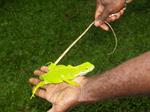Study Zookeeping - Take a step forward to achieving your goal

Are you interested in working in a zoo?
Do you want to learn more about zoo keeping?
This could be the course for you...
This course is ideal for you if you have a passion for animals and are interested in starting a career with animals. Learn all about zoos and the principles of keeping animals in a zoo with our Zoo Keeping course. Learn how to care for and manage animals in captive environments. This course covers animal care, enclosure designs, captive breeding, human-animal interactions, education and conservation and many other considerations on upholding the wellbeing of animals that are in captivity.
If you have always dreamed of working with animals and need a starting point and foundation knowledge, then this Zoo Keeping course is perfect for you.
Lesson Structure
There are 9 lessons in this course:
-
The Nature and Scope of Zoos
-
What is a Zoo?
-
The Evolution of Zoos
-
Change in Zoo Design
-
Modern Zoos and Sanctuaries
-
Legislation
-
Codes of Practices
-
Animal Welfare
-
Enrichment
-
Record Keeping
-
Identification Tags
-
Animal Taxonomy
-
Phyla & Classes of the Animal Kingdom
-
The Function of Zoos
-
Research and Zoos
-
Education in Zoos
-
Occupational Health and Safety in Zoos
-
Workplace Health & Safety
-
Legislation
-
Health & Safety Management in Zoos
-
Zoonoses
-
Legionnaires Disease
-
Other Safety Issues
-
Risk Management
-
Captive Husbandry - Nutrition and Feeding
-
Animal Nutrition
-
The Effect of Poor Nutrition on Animal Behaviour
-
Water Requirements
-
Essential Dietary Components
-
Vitamins & Minerals
-
Food Storage & Preparation
-
Presentation of Food
-
Captive Husbandry - Health
-
Monitoring Health
-
Maintaining Health
-
Diseases
-
Quarantine
-
Record Keeping/Animal Transfer Data
-
Enrichment Data Transfer Form
-
Captive Husbandry - Reproduction
-
The Need for Captive Breeding
-
Captive Breeding in Zoos
-
Goals of Captive Breeding
-
Issues with Captive Breeding
-
Inbreeding Risks
-
Captive Breeding Programs
-
Monitoring the Reproductive Status of Zoo Animals
-
Assisted Reproduction
-
Stud Books
-
Birth Control and Separation
-
Captive Husbandry - Behaviour and Enrichment
-
Ethology
-
Behaviour
-
Types of Behaviour
-
Behaviours in Captive Animals
-
Learned Behaviour
-
The Flight or Fight Response
-
Animal Behaviours
-
Animal Welfare Indicators
-
Environmental Influence on Behaviour
-
Behaviour Management
-
Environmental Enrichment
-
Human-Animal Interactions
-
Keeper-Animal Interactions
-
Visitor Animal Interactions
-
Dealing with Dangerous Animals
-
Flight Distance of Animals
-
Handling Animals
-
Visitor Animal Interactions
-
Stress Reduction
-
Enclosure Design and Maintenance
-
Optimum Enclosure Design
-
The Perfect Enclosure?
-
Replicating Nature
-
Providing Stimulating Environments
-
Physical Enrichment
-
Feeding Enrichment
-
Sensory Enrichment
-
Social Enrichment
-
Problem-based Learning Project - Environmental Enrichment
-
Introduction and Definition of PBL
-
Problem Definition
-
Team Structure and Interaction
-
Discussion
-
Resources
-
Guidelines
-
Final Report
Each lesson culminates in an assignment which is submitted to the
school, marked by the school's tutors and returned to you with any
relevant suggestions, comments, and if necessary, extra reading.
Aims
- Describe the nature and scope of zoos as a source of education and conservation
- Develop appropriate procedures for managing occupational health and safety in a zoo, with a view to minimising risk to staff, animals and visitors
- Describe the nutritional requirements and feeding preferences of animals within zoos
- Determine health management measures required for a range of different captive zoo animals
- Describe the management of breeding in zoos
- Determine appropriate ways to manage a range of different wild animals in zoos
- Explain procedures and techniques used to manage human-animal interactions in zoos
- Identify and describe the qualities of good enclosure design. Develop maintenance
Issues with Handling Animals

When planning to handle animals, the benefits of handling should be weighed against possible harm to the animal, to other animals, or other potential costs. These costs can include specialised equipment, labour, and facilities, and methods for reducing the stress to the animal.
In addition to potential physical problems associated with handling, many of the issues that must be dealt with are psychological. Because we cannot communicate our intention or reassure the animal that the handling is in its own best interest (when it is) or otherwise necessary, and the animal may not even possess the faculties for understanding such issues anyways, we run the risk that the animal will perceive handling as stressful, and potentially dangerous, and act accordingly.
One way to reduce stress is to identify and utilise symbolic language (signals) that elicit more cooperative responses or reduce stress. These can include simple stroking (which can help calm Equids), whistling (dogs respond to short, high notes), lowering ourselves to their level (which can reduce anxiety in some animals), making familiar hand signals (with animals trained to respond in particular ways to the signals), and making soothing noises to which the animal has learned to respond.
Signals, voice, gestures, and stance can do much to help avoid fearful reactions. However, an animal can quickly become anxious in unfamiliar situations, and once frightened, are difficult to calm down.
An Experiential online course
Unlike other online courses, our courses offer you the added opportunity to apply your knowledge through activities encouraging you to undergo tasks, network with industry professionals, carry out extra research etc, giving you an experiential course. Compared with many other online courses, our courses are more in depth and the level of support you will receive is higher.
If you would like to be a zookeeper, then why delay? Enrol today and get started.

You can
enrol on the course now, but if you have any questions about the content
of the course or studying with ACS, then please get in touch with us
today - use our FREE COURSE COUNSELLING SERVICE to get in touch with our expert tutors. They will be pleased to help you!
